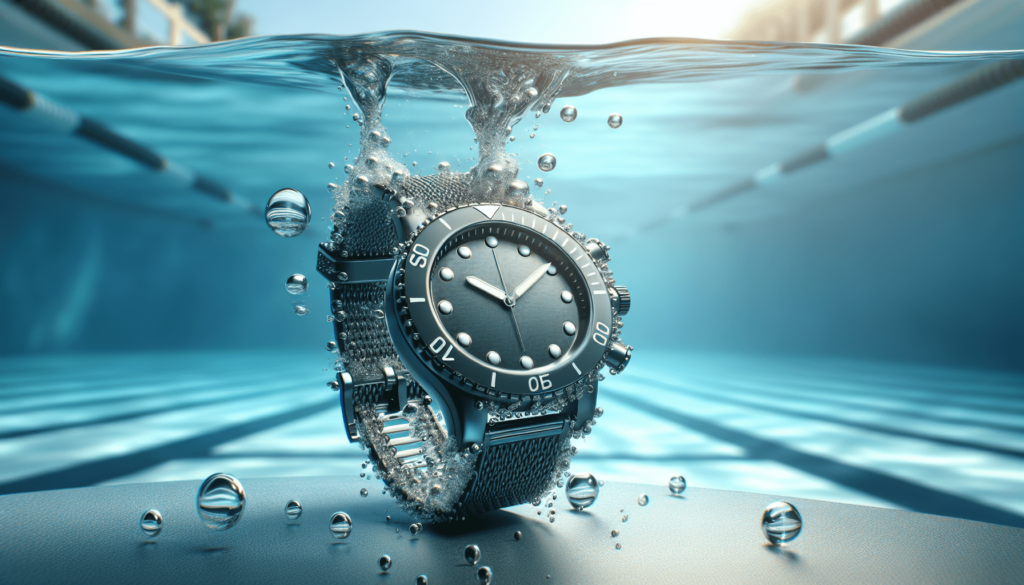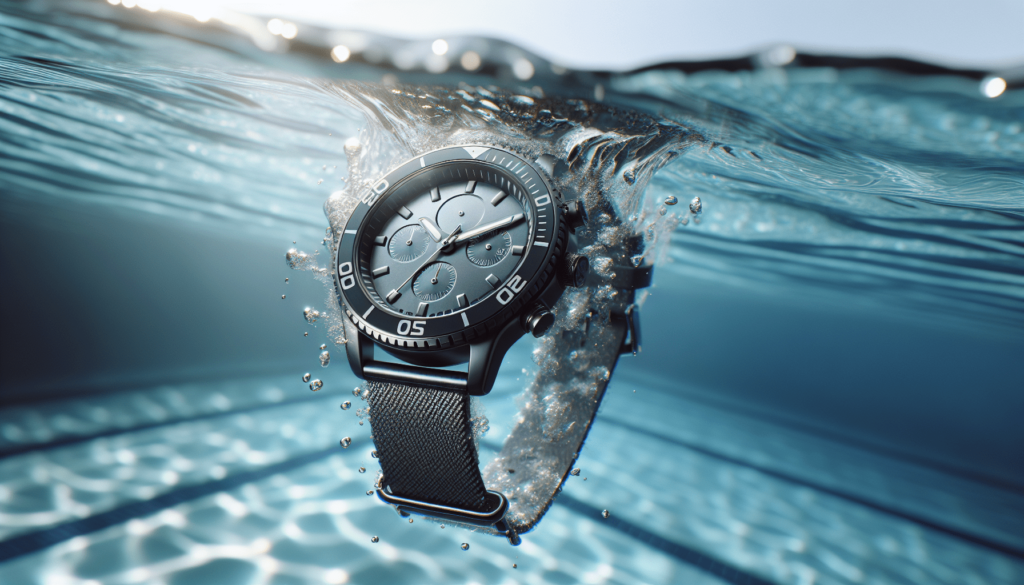Have you ever wondered which watch would best suit your aquatic adventures? Whether you’re training for a triathlon, perfecting your butterfly stroke, or simply enjoying a leisurely dip, a good swimming watch can make a world of difference. The task of finding the right timepiece for your wrist, capable of functioning underwater, may seem daunting. This guide aims to simplify your decision-making process by outlining the best features, brands, and considerations when choosing a swim-friendly watch.

What Makes a Watch Suitable for Swimming?
Water Resistance
The main feature you need in a swimming watch is water resistance. Watches come with a variety of water resistance ratings, usually measured in meters.
| Rating | Suitable For |
|---|---|
| 30 meters | Splashing or brief immersion, but not suitable for swimming |
| 50 meters | Suitable for shallow swimming |
| 100 meters | Safe for swimming, snorkeling, but not for diving |
| 200+ meters | Ideal for swimming, snorkeling, and even scuba diving |
The rule of thumb is to aim for a watch with at least 100 meters of water resistance for regular swimming activities.
Material
Your watch’s material plays a significant role in its durability and comfort. Typically, swimming watches come in stainless steel, titanium, or various types of plastic. The band, on the other hand, is often made of rubber, silicone, or resin to withstand constant moisture and provide a comfortable fit.
Stainless Steel and Titanium
Stainless steel and titanium are durable and resistant to corrosion, making them ideal choices for swimming. Titanium is lighter than stainless steel, adding comfort during prolonged use.
Plastic and Resin
Plastic and resin watches are usually lighter and often less expensive. They provide flexibility and are generally very comfortable for wearing over long periods in the water.
Durability
Durability encompasses more than just the materials used; it’s about how the watch stands up to tough conditions, including exposure to chlorine, saltwater, and UV rays. Look for watches that advertise enhanced durability to avoid disappointments.
Readability
Clarity and readability are critical, especially underwater. Opt for watches with large, clear dials and luminous hands or digital displays that remain visible in low-light conditions.
Key Features to Consider
While water resistance and material durability are paramount, other features can greatly enhance your swimming experience.
Lap Tracking
For competitive swimmers and serious trainers, lap tracking is a must-have feature. It allows you to measure your performance, track your speed and pace, and calculate the number of laps you complete. Many modern swim watches come with built-in lap counters.
Heart Rate Monitoring
Some swimmers prefer to keep track of their heart rate while working out. Watches equipped with heart rate monitors can offer valuable insights into your cardiovascular fitness.
GPS Functionality
Although GPS might sound more relevant for runners and cyclists, it can be beneficial for open-water swimmers too. GPS-enabled swimming watches help track your swimming route, distance covered, and speed in open waters.
Smartwatch Capabilities
Many modern watches blur the lines between traditional timepieces and smart devices. Features like Bluetooth connectivity, app compatibility, notifications, and music control can be useful even when you’re swimming. However, these added functionalities usually come at a higher price point.
Top Brands and Recommendations
Garmin
Garmin is renowned for producing high-quality sports watches with extensive features for different activities, including swimming.
Garmin Swim 2: Specifically designed for swimmers, this watch includes features like underwater wrist-based heart rate, GPS for open-water swimming, and advanced swim analytics.
Garmin Forerunner 945: While not exclusive for swimming, this versatile watch supports multiple sports activities and features water resistance up to 50 meters, making it a good choice for varied athletic pursuits.
Apple
Apple Watches have gained popularity due to their multifunctionality and sleek design.
Apple Watch Series 6 and 7: Both series are water-resistant up to 50 meters and come with swim tracking capabilities. They include features such as heart rate monitoring, GPS, and cellular options.
Suunto
Suunto offers robust watches suitable for extreme sports, including swimming.
Suunto Spartan Trainer Wrist HR: Known for its durability and extensive features, this watch works exceptionally well for swimmers thanks to its water resistance up to 50 meters and wrist-based heart rate monitoring.
Samsung
Samsung’s Galaxy series has made waves in the market for smartwatches with multiple functionalities.
Samsung Galaxy Watch: With a water resistance rating of 50 meters, this watch also offers GPS tracking and swim monitoring features.
Casio
Casio is another reliable brand known for its durable, water-resistant watches.
Casio G-Shock Series: These watches are generally designed to endure tough conditions and provide reliable water resistance, making them a solid choice for swimmers.
Pros and Cons of Smartwatches vs. Traditional Sports Watches
Smartwatches
Pros:
- Multifunctional: Offers app connectivity, notifications, and versatile usage beyond swimming.
- Sleek Designs: Often modern and stylish.
- Continuous Updates: Regular software updates can add new features.
Cons:
- Battery Life: Often needs to be charged more frequently.
- Higher Cost: Generally more expensive due to additional functionalities.
Traditional Sports Watches
Pros:
- Durability: Usually more rugged and resistant to wear and tear.
- Longer Battery Life: Can last weeks on a single charge.
- Simplicity: Easier to use with fewer distractions.
Cons:
- Fewer Features: Lesser multifunctionality compared to smartwatches.
- Outdated: Lacks modern technological updates and integrations.

Maintenance Tips for Your Swimming Watch
Rinse After Each Use
Especially if you swim in saltwater or pools, it’s crucial to rinse your watch with fresh water after each swim. This helps to remove corrosive elements like salt and chlorine.
Regular Check-ups
For watches with a water resistance rating, ensure you get them checked regularly. Gaskets and seals can degrade over time, compromising the watch’s water resistance.
Proper Storage
When not in use, store your watch in a cool, dry place. Extended exposure to sunlight, moisture, or extreme conditions can damage both the watch’s functionality and its appearance.
Band Care
The band is often the first part to show wear and tear. Clean it regularly to maintain its condition and prevent any sort of fungal or bacterial growth.
Battery Replacement
If you opt for a traditional sports watch, keep an eye on the battery life. Replace the battery as needed to avoid sudden failure during a swim session.
Conclusion
Choosing the perfect watch for swimming involves considering multiple features and personal preferences. The most critical elements include water resistance, material durability, and readability. Additional features like lap tracking, heart rate monitoring, and GPS can enhance your swimming experience but come at an added cost.
Among the many available options, brands like Garmin, Apple, Suunto, Samsung, and Casio have established themselves as reliable manufacturers. Carefully assess the pros and cons of smartwatches versus traditional sports watches to determine the best fit for your needs.
Remember, taking proper care of your swimming watch will ensure its longevity and consistent performance. Happy swimming!

